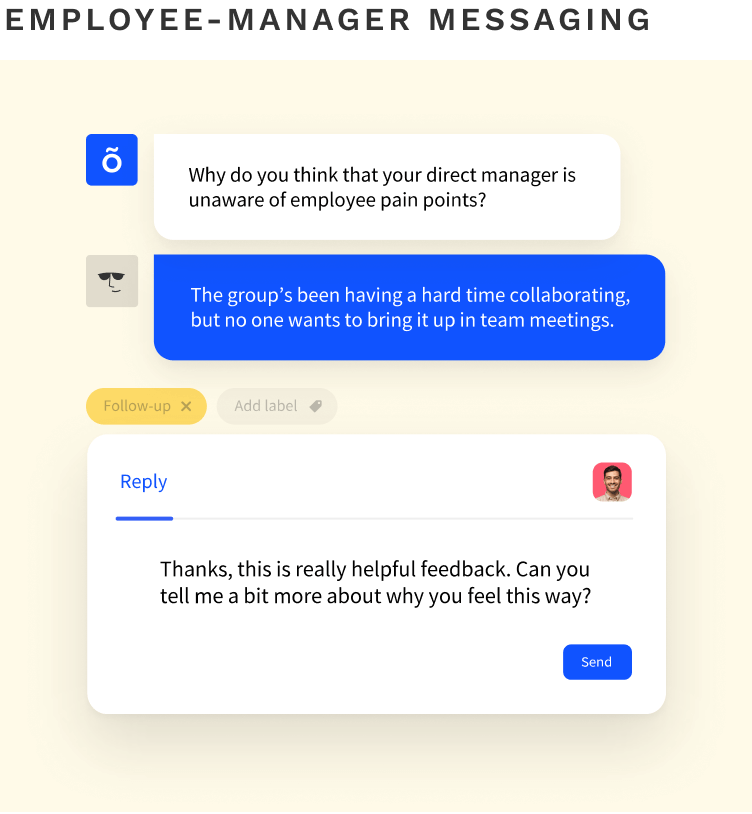Good communication at work plays an essential role in each and every responsibility you have.
Whether you're building relationships, managing conflict, or explaining clear objectives: you set the tone when it comes to learning why good communication skills are important.
Adding remote work into the mix, effective ways of communicating become fundamental for a positive employee experience.
To help improve both the quality and frequency of communication on your team, we put together 13 tips for effective workplace communication with an emphasis on helping distributed teams.
Exclusive online summit
·
May 23 2024
Moments that matter: how to seed great work
What's in this article
- 1. Practice authentic communication
- 2. Create a communication-friendly culture
- 3. Keep workplace communication constant
- 4. Hold weekly team meetings
- 5. Offer a platform for anonymous feedback
- 6. Ask for employee feedback
- 7. Communicate face-to-face
- 8. Master your body language
- 9. Know when less is more
- 10. Take time to listen
- 11. Personalize your communications
- 12. Set aside time for non-work related discussions
- 13. Prioritize workplace communication training
1. Practice authentic communication
Internal communication may often feel rehearsed, which makes some messaging less meaningful. Encourage your team to stay authentic. Not only will this help with productivity and engagement, but it will also help your team know that they can speak up when they need to.
As a manager, you set the example. Emphasize your humility and vulnerability. This will help others feel a level of approachability as well as indicates that they too can share their perspectives.
For example: When you communicate with sincerity by admitting to mistakes or not having all the answers, you establish psychological safety. This helps to level the playing field for others to do the same. Once that seed of authenticity is planted, everything from building solid relationships to having difficult conversations becomes that much easier.
2. Create a communication-friendly culture
To make sure your day-to-day is communication-friendly, set your team up with the right tools for online communication. Apps like Slack and Zoom are great for staying connected with remote employees and make communication feel accessible and collaborative even from afar.
In a communication-friendly culture, it's essential to emphasize the importance of expressing emotions, and ideas, and being unafraid to bring up difficult conversations.
Teams who show a high level of productivity have established psychological safety in their communication. In fact, many value trust and open communication and see it as integral to their team's success. This is especially true when broaching tough conversations.
Tip:
At Officevibe, we have a set of team norms that act as our guiding principles. These outline acceptable behaviours and one of these values underscore communication: "Call out the elephant in the room".
Essentially this means that we hold team members accountable to make sure we're not sweeping important issues under the rug.
3. Keep workplace communication constant
Maintain a healthy communication flow with your team. Instead of relying on annual reviews to discuss performance and goals, find the time for monthly 1-on-1s.
Holding yourself and your team accountable to stay up to date on each other's workload, morale, and resources will nurture two-way conversations. Not only does this help with employee productivity, but it also boosts employee motivation and engagement.
Don't rely on reading body language from afar. You'd be surprised how much your team has to say if 1-on-1s or team catch-ups didn't initiate important conversations.
There are also amazing tools for online communication that can help you organize your streamlining. See which one fits your team better.
4. Hold weekly team meetings
In addition to monthly one-on-one meetings, schedule the same sort of initiative but for the whole team in an open forum.
During prolonged times of uncertainty, having more frequent meetings will be helpful to re-communicate goals, and objectives, collaborate on projects and discuss shifts in strategies. This is also a great time for the team to ask questions and get on the same page.
Tip:
Individuals may feel too awkward to bring up questions in a virtual group setting. Remember, you are the leader. Normalize sharing candid thoughts by demonstrating your own curiosity. Ask your team questions that prompt reflection and leave space for them to answer.
💡 Instead of "is there anything unclear about the new strategic direction?" try "what part of the new direction is lacking clarity?" or "what excites you about our upcoming projects?'
Also, if you're working remotely, your team might be missing some of the benefits of physical meetings. You need to be ready to smoothly transition to the future of work: a hybrid reality that includes remote work and periodic face-to-face interactions.
Incorporating co-working spaces that enable productive and efficient collaboration, could be the best approach to combining remote and physical work.
5. Offer a platform for anonymous feedback
Allowing anonymous feedback is crucial for effective workplace communication. Sometimes, employees shy away from sharing feedback.
They might be hesitant to make a complaint or divulge their authentic thoughts and emotions openly. In this case, the option for anonymity facilitates the process of sharing more difficult sentiments, which are key insights for managers.

❤️ Officevibe helps managers improve team communication and build a culture of continuous feedback
We take communication seriously and put continuous effort into ensuring that our product helps managers and teams master effective, two-way communication. Here’s how:
- Our anonymous feedback tool allows employees to share their thoughts anonymously, and lets managers respond to the feedback directly in the platform. Opening up a dialogue about issues in real-time helps start important conversations before problems become too big.
- Answering feedback isn’t always easy. Our latest Feedback Guidance Feature guides managers in responding to all sorts of feedback. We’ll always be there to guide you, but you’ll improve over time, and eventually, answering even the toughest feedback will become natural to you.
- We believe in meaningful, effective, and collaborative communication, always. Our one-on-one tool lets managers and employees set talking points in a collaborative agenda and even helps managers kick-start discussions with dozens of Conversation Starters that are proven to promote solution-finding and openness.
6. Ask for employee feedback
Effective communication is never top-down or one-way. Always give the team the chance to give you, their leader, feedback.
For example: Ask teams to communicate their feedback on your performance as a manager. Or ask them to share their input on the upcoming strategy you presented. The idea is to keep lines of communication open and get rid of hierarchical barriers. Everyone has something to learn, especially managers.
💥We created a Toolbox for managers with frameworks, guides, templates, and checklists to get them through their most common management challenges.

7. Communicate face-to-face
Using tools like Slack and email is efficient, however, they're not the most ideal for building lasting connections.
It's important to remember that face-to-face communication holds a great amount of value when it comes to sincerity and authenticity. In-person conversations aren't always accessible, but there are ways to facilitate this in a remote work environment.
Part of effective communication is human interaction. With this in mind, try speaking instead of typing as often as possible without disrupting the flow of work.
This will further facilitate getting to know your team's body language, personality, and tone. It's especially helpful when it comes to giving feedback.
Tip:
If you can't be face-to-face, try hosting video calls rather than phone calls. They help to reduce distractions during important conversations and strengthen peer-to-peer interactions when you and your employees can't physically be in the office.
8. Master your body language
Non-verbal communication is important. Your body language has a huge impact on how people perceive you and gauge reactions.
Communicate with physical presence and ensure that your body language is open and approachable. When working remotely, your body language speaks volumes. Here are a few key points to keep in mind:
- Smile (if you're feeling it). Seeing your teammate smiling back at you is comforting!
- Keep your arms uncrossed to demonstrate openness
- Maintain an upright posture to show your engagement
- Maintain eye contact. Looking into the camera when you speak and looking at the person speaking when it's their turn shows that you're present.
- Turn off device notifications to minimize distractions
9. Know when less is more
In a perfect world, employees can power down after work hours and stop checking emails. The truth is, many of us are so connected to our jobs and our devices.
The line between a healthy work-life balance gets blurred even further while we're working from home. Building a boundary is helpful to achieve a healthy work-life balance. Make sure you keep the number of emails you send after core hours to a minimum. While communication is important, rest is equally a priority.
According to data we collected during the transition to remote work, 32% of employees don't feel they have a proper balance between their work and personal life. As a manager, employees look to you to lead by example and help draw clear boundaries.
10. Take time to listen
One of the most essential and meaningful elements of communication is practicing active listening. It's like the old adage: we have two ears and only one mouth for a reason. Listening to your team gives them the space to share honest and transparent feedback.
Bonus: it shows empathy and promotes healthy professional relationships with humility at the base.
Here are 3 quick tips to help you be a more active listener:
- Normalize comfortable silences: Leaders might dominate conversations. It's important to lead by listening. Open-air gives people time to reflect and think about how they can contribute to the conversation.
- Be present: It may seem obvious, but listening means focusing on the interaction in front of you. Put your phone away, turn your notifications off, and dedicate your attention to being here, now.
- Confirm what you know: Repeat what's been brought up. Let the other person know that you were truly listening by confirming what you heard. This ensures you're both on the same page and can move forward with clarity.
11. Personalize your communications
Understanding your employees' individual communication style takes time.
Great leaders know that it's worth being patient. Being mindful of the way you communicate and how this will land with the people you speak to, goes a long way and has a big impact. Consider this:
Employee A might prefer to communicate in a private space and appreciate specific examples when receiving feedback.
Employee B might like to walk and talk during difficult conversations because it requires less direct eye contact, rendering the conversation less formal.
Employee C might have a hard time communicating altogether. This would be a good time to work on communication techniques as part of their development.
One way to discover each employee's communication preference is to ask:
- What is the best way I can share feedback with you?
- What is most important to you when it comes to communication at work?
- What do you find difficult about communicating?
12. Set aside time for non-work related discussions
Employees are multidimensional people. That person from marketing might have interesting travel stories, or that new person on your team might be working towards a big personal fitness goal.
Whatever the case may be, knowing that you’re communicating with people initiates empathy. Talking about topics beyond the scope of work leads to positive relationships and strong team dynamics.
Try this activity:
Ask everyone to share a piece of information that no one at work knows about them. Write it down on a piece of paper. Throw it into a bowl. Shuffle each piece of paper around. Now, work together to guess who it belongs to. You’ll be surprised what you learn about each other! You can even draw names in a remote setting using a tool like Name Picker.
13. Prioritize workplace communication training
Emphasize the importance of communicating effectively with your team. This is especially important for managers to nip bad habits in the bud.
At Officevibe, we’re enrolled in Conscious Communication training (also known as Non-Violent Communication training). Initially, the program was limited to our managers, but the benefits were so great that now 300+ employees are taking part in a two-day workshop! The goal is for everybody to become more self-aware when it comes to communication. We’ve especially noted the impact our choice of words has on teams.
Effective communication leads to engaged employees. It helps everyone understand what’s going on in the company and what’s expected of each other.
It helps us build relationships, have tough conversations, and successfully tackle problems. It removes ambiguity, stress, and confusion that is compounded while working remotely. Communication is the thread that ties through all successful teams.
Our feedback guide helps you put these tips into practice. Check it out and tell us about your experience!
Equip HR and managers with tools to engage, recognize, and drive performance.




